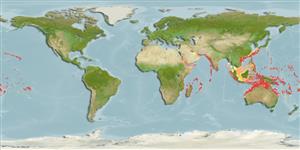>
Perciformes/Serranoidei (Groupers) >
Epinephelidae (Groupers)
Etymology: Epinephelus: Greek, epinephelos = cloudy (Ref. 45335).
Eponymy: Mr. Retout (no other names given) of Mauritius contributed to the natural history collections made by François Pollen (q.v.) for the Leiden Museum. (Ref. 128868), visit book page.
More on author: Bleeker.
Environment: milieu / climate zone / distribuzione batimetrica / distribution range
Ecologia
marino associati a barriera corallina; distribuzione batimetrica 20 - 220 m (Ref. 5222). Tropical; 36°N - 27°S, 37°E - 143°W (Ref. 5222)
Indo-Pacific: islands in tropical and subtropical waters from the western Indian Ocean to Jarvis Island (Line Islands, Kiribati) and French Polynesia (Ref. 4787), including Bassas da India (Mozambique Channel) (Ref. 5222).
Size / Peso / Age
Maturità: Lm ? range ? - ? cm
Max length : 50.0 cm TL maschio/sesso non determinato; (Ref. 5222); common length : 30.0 cm TL maschio/sesso non determinato; (Ref. 9137); peso massimo pubblicato: 2.0 kg (Ref. 5222)
Spine dorsali (totale) : 11; Raggi dorsali molli (totale) : 16 - 17; Spine anali: 3; Raggi anali molli: 8. Similar to E. fasciatus, differing primarily by having straighter head profile and longer snout, red rather than black tips on spinous dorsal fin (Ref. 37816). Distinguished by the following characteristics: adults dull yellowish orange to brownish red, each scale on the dorsolateral part of the body with dark greenish grey spot; usually 5 faint dark bares on body, 2nd and 3rd bars extend onto the spinous dorsal fin where they are dark brown; dorsal fin greenish brown, soft rayed part darker than rest of the fin, outer triangular part of interspinous membranes dark red, set off from the rest of the fin by an orange-yellow stripe; dark greenish brown dorsal fin margin of caudal fin; dark red or brown line along base of dorsal fin; narrowly edged orbit, except anteriorly, with dark red; pale blue line adjacent to the red rim of the orbit and completely surrounding eye; body depth contained 2.5-3.1 times in SL; head length 2.4-2.6 times in SL; flat to slightly convex interorbital, dorsal head profile slightly convex; rounded preopercle, finely serrate; sinuous upper edge of operculum; snout length 3.5-3.9 times in HL; subequal anterior and posterior nostrils; maxilla reaches below rear half of eye; 3-4 rows of teeth on midlateral part of lower jaw; pair of short fixed canines at front of both jaws; numerous pyloric caeca (Ref. 89707).
Body shape (shape guide): fusiform / normal; Cross section: compressed.
Adults are found in depths of 70 to 220 m on outer reef slopes; the young in depths of 20 to 40 m (Ref. 89707). Also caught with vertical longlines.
Life cycle and mating behavior
Maturità | Riproduzione | Deposizione | Uova | Fecundity | Larve
Heemstra, P.C. and J.E. Randall, 1993. FAO Species Catalogue. Vol. 16. Groupers of the world (family Serranidae, subfamily Epinephelinae). An annotated and illustrated catalogue of the grouper, rockcod, hind, coral grouper and lyretail species known to date. Rome: FAO. FAO Fish. Synop. 125(16):382 p. (Ref. 5222)
IUCN Red List Status (Ref. 130435: Version 2025-1)
Threat to humans
Harmless
Human uses
Pesca: pesca di sussistenza; Pesce da pesca sportiva: si
Strumenti
Special reports
Download XML
Fonti Internet
Estimates based on models
Preferred temperature (Fonte Biblio.
123201): 20.8 - 28.1, mean 26.1 °C (based on 472 cells).
Phylogenetic diversity index (Fonte Biblio.
82804): PD
50 = 0.5000 [Uniqueness, from 0.5 = low to 2.0 = high].
Bayesian length-weight: a=0.01175 (0.00568 - 0.02430), b=3.04 (2.88 - 3.20), in cm total length, based on LWR estimates for this Genus-body shape (Ref.
93245).
Trophic level (Fonte Biblio.
69278): 4.0 ±0.65 se; based on food items.
Resilienza (Fonte Biblio.
120179): Medio, tempo minimo di raddoppiamento della popolazione 1.4 - 4.4 anni (Preliminary K or Fecundity.).
Fishing Vulnerability (Ref.
59153): Moderate vulnerability (40 of 100).
🛈
Nutrients (Ref.
124155): Calcium = 26.1 [12.5, 54.2] mg/100g; Iron = 0.474 [0.256, 0.953] mg/100g; Protein = 18.5 [16.9, 19.9] %; Omega3 = 0.142 [0.090, 0.227] g/100g; Selenium = 44.3 [26.0, 76.1] μg/100g; VitaminA = 188 [55, 660] μg/100g; Zinc = 1.21 [0.85, 1.69] mg/100g (wet weight);
